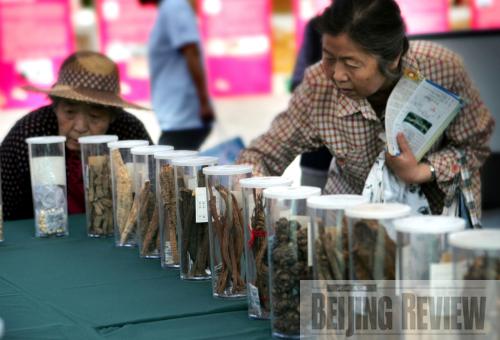|
 |
|
LEARN CAREFULLY: Two visitors survey samples of TCM herbs at the Beijing TCM Week on May 23 (ZHAO BING) |
In 2003, an herb called indigowoad root very quickly became popular and sold out of most Chinese drug stores. With Severe Acute Respiratory Syndrome (SARS) sweeping through the country and killing nearly 1,000 people, this herb was said to be effective in preventing the disease.
Deng Tietao, a traditional Chinese medicine (TCM) doctor from Guangdong Province renowned as the greatest practitioner in China, gave prescriptions to prevent the disease and other remedies to treat some patients according to their own physical conditions. With his efforts, the spread of SARS slowed down in Guangdong Province and it became the first province in China's mainland to effectively counter the epidemic.
Liu Qingquan, a TCM doctor of Beijing's Dongzhimen Hospital, joined in the study and research to find Western and TCM therapies for SARS in 2003. "Before that, TCM was totally excluded from the epidemic treatment system."
It was the first time that TCM was officially introduced into the country's infectious disease treatment system. It was also the first time in China that TCM was incorporated with Western medicine to fight the epidemic and TCM doctors were allowed to enter epidemic wards.
Last year, when hand foot and mouth disease killed people in Anhui Province, Liu was assigned to lead a medical team there and prescribed TCM remedies. This year, on May 11, he was the only TCM expert on the government medical team that went to Sichuan Province to fight A/H1N1 flu.
TCM, being increasingly used for epidemic prevention and treatment, has its own prescriptions and explanation for the growing A/H1N1 flu epidemic that has made its way around the globe.
The China Association of Chinese Medicine, the largest TCM association in the country, recently posted a TCM treatment prescription including indigowoad root for the flu on its official website. Yang Hongzhi, who posted the prescription, is a TCM doctor in Zhongshan University's No. 3 Hospital in Guangdong Province. Yang also suggested other ready-made Chinese medicines, such as a cordate houttuynia injection, which aims to relieve the internal heat in the lung, and Chinese thorowax granules, which TCM says balances the function of the liver.
It is just flu
According to the Ditan Hospital in Beijing, the flu spreads between humans through coughing or sneezing and diagnosis can be made by sending a specimen, collected during the first five days for analysis. Methods of preventing the spread of influenza among swine include facility management, herd management and vaccination and the treatment on human beings involves the use of antiviral drugs.
TCM treats it in another way. "Using TCM to judge, the A/H1N1 flu is just a normal influenza," said Fan Zhenglun, a TCM doctor at Beijing's Pingxintang Clinic who gave a series of TCM lectures on China Central Television (CCTV). "The way we treat this flu is no difference from the way we treat any other flu."
Fan explained that TCM and Western medicine treat diseases totally differently. He said that the Western way is to find the virus that causes the disease and stop the replication of it. But TCM dictates that all diseases are caused by imbalances in human bodies, he said, and doctors need to focus on recovering the balance.
| 